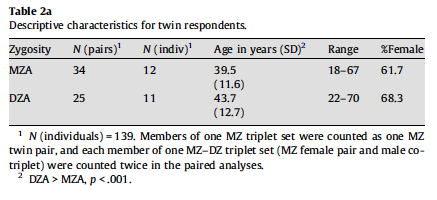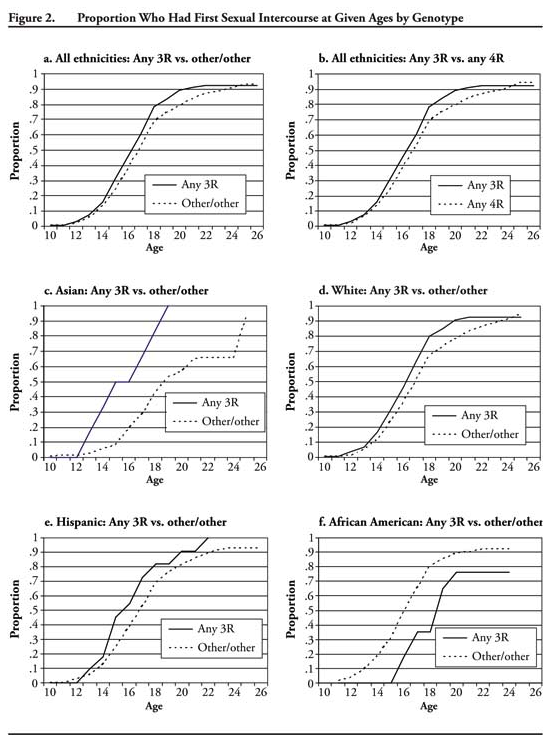Article One: "Age at first intercourse in twins reared apart: Genetic influence and life history events"
(Segal et al., 2009)
Published in 2009 by researchers at California State University, this article focuses on the analysis of many factors including age of first intercourse in fraternal (DZ) and identical (MZ) twins. It is mainly a statistical study to determine if a genetic factor plays a role in the age at which an individual has intercourse for the first time. Comparing identical and fraternal twins allows researchers to distinguish genetic influences without searching for specific genes. In other words, if identical twins share a ". . . greater similarity in the timing of first sexual intercourse. . . " compared to fraternal twins, then the likelihood that genes may contribute to the timing of loss of virginity is high, because identical twins share the same DNA whereas fraternal twins are assumed to share half of their DNA (Guo et al., 2006). This article does not complete any sort of indepth genetic tests, it only explores the possibility of genetic link through studying many different sets of twins.
Methodology:
The sample included 34 identical twin pairs, 25 fraternal twin pairs, and 23 individual twins that were separated since birth. Note that the A at the end of the distinctions indicate that the twins were raised apart.

| Table 2a: This table summarizes the sample of twins studied and their average ages and gender proportions (Segal et al., 2009). |
The twins completed questionnaires not just about their sexual life but also their childhood home and peer environments and their sexual development. They were also asked age of first kiss, marriage, and first child. Researchers found that the twins' age highly correlated with the age at which they first had sexual intercourse and therefore the twins were organized into two birth groups for statistical analysis: 1) twins born between 1917-1947 and 2) twins born between 1948-1970. The twins were also separated by gender in the statistical analysis.
Results:
Researchers found many correlations with age of first sexual intercourse and what they termed "life history events." For instance, age of first sexual intercourse was highly correlated with age of first kiss, marriage and first child. It was also related to feelings of "happiness relative to peers and feelings of fulfillment in the rearing home," meaning that the less happy had intercourse at an earlier age. The statistical analysis led researchers to conclude that ". . . about 34% of the variance in AFI [age of first intercourse] is associated with genetic factors." This conclusion is based on a statisical analysis of correlation coefficients in identical twins raised apart where 34% of them correlated in age of first intercourse (Segal et al., 2009).

| Table 4: This table outlines the correlation coefficients (r) for the many different categories of twins studied. It is important to note that in identical twins raised apart studied there was a correlation of 34% between age of first intercourse. This was the main evidence of a genetic role (Segal et al., 2009). |
Overview:
Although this is a very brief overview of an intense physiological study, their main conclusions were: 1). age of first intercourse correlates with "life history events," and therefore is not completely determined by genetics and 2). a genetic component may play a role in the age of first intercourse based off of statistical correlation coefficients for the age of first intercourse in identical twins that were raised apart. It is important to note that the article does highlight some major limitations (small sample size and inconsistencies in interviews) in their statistical study and also notes future directions they hope to take (more research in the social developmental factors that may play a stronger role).
Article Two: "Age of first sexual intercourse, genes and social context: evidence from twins and the dopamine D4 receptor gene."
(Guo et al., 2006)
This article, published by researchers at UNC-Chapel Hill in 2006, outlines the main support for the link between the DRD4 gene and the age of first intercourse. The article provides the genetic meat behind the possible genetic component of age of first sexual intercourse. Authors, Guo and Tong, did an excellent job presenting in-depth research descriptions and results. Their article was lengthy but provided a firm genetic connection, what other articles had failed to do. It is a complicated paper with many interesting facets and the snippets below are just meant to give a quick look at their research and findings.
Methodology:
This study completed two different types of analysis: 1). non-DNA analysis of identical and fraternal twins which revealed that a genetic contribution to the age of first intercourse existed and 2). DNA analysis focusing in on a 48 bp repeat polymorphism in the dopamine receptor D4 gene (DRD4). Since the twin analysis is strikingly similar to the article summarized above, except with increased diversity and larger sample size, I will focus on the second analysis because it is unique to this paper. The researchers also explored the connection between age of first intercourse and socioeconomics factors such as ethnicity, family structure, parental education and neighborhood poverty rates.
What is the DRD4 Gene?
The DRD4 gene encodes a G-coupled dopamine receptor known as the D4 dopamine receptor (it is one of 5 types of dopamine receptors). Dopamine is a neurotransmitter necessary to the functioning of the central nervous system (Harrison, 2007). It is often related to sensations of pleasure and activates the reward circuit in our brain by binding to dopamine receptors, such as the D4 receptor studied here. Below is a picture of the chemical dopamine.
The availability of dopamine levels depends on the receptor binding of the "synaptic neurotransmitters" (Guo et al., 2006). In other words, the dopamine receptors play a critical role in regulating how much dopamine is released and how dopamine controls certain aspects of our nervous system.
The DRD4 gene is 3.4 kb long and is located at 11p15.5 (Guo et al., 2006). Below is a picture that maps this gene in the human genome.
Researchers discovered that there is a functional 48-bp VNTR polymorphism in exon 3 of the DRD4 gene, which has been identified as the region of the gene that encodes for one of the loops on the receptor (750). The most common polymorphism is the 4R (meaning 4 repeats). Researchers have identified that the 2R and 7R alleles produce proteins that have decreased affinity for dopamine and therefore the brain reward circuit requires more dopamine to function normally (Guo et al., 2006). Researchers in this study explored a connection between age of first intercourse and 2R, 3R, 4R and 7R alleles of the DRD4 gene.
The researchers explored this linkage between specific DRD4 alleles and the age of first intercourse using data from the National Longitudinal Study of Adolescent Health. There were 2,552 subjects of study with a wide range of ethnic, social and economic diversity. They used complicated statistical methods to show correlation between certain alleles and certain sub-groupings such as ethnicity, parental education, et cetera.
Results:
Below are the graphs of proportions of individuals versus age of first intercourse for individuals with any 3R allele as part of their genotype (suggesting a dominant inheritance) and any other genotype without the 3R allele.
Figure 2: These graphs show the proportion of individuals that have had intercourse at a spceific age. The individuals are divided into people who have a 3R allele at the DRD4 gene locus and others. As you can tell for a-e the individuals with a 3R allele have increased proportions of participating in sexual intercourse for most ages (Segal et al., 2009). |
As you can tell by the figure above in almost all graphs there is a significant increase in the proportion of individuals at a younger age (at all ages) when the 3R allele exists in the individuals genotype. The data for the African American plot is considered statistically irrelevant because the apparent difference between the two lines was not statistically significant at an acceptable level. These charts show that there is a link between genetically having a 3R allele of the DRD4 gene and having intercourse at a younger age.
Although the article does not specifically address the reasons why, I believe that the 3R allele may bind dopamine more frequently and at a higher affinity as compared to the 2R and 7R alleles that have bind at a lower affinity and the 4R which is the most common allele. If dopamine binds with more affinity then this can lead to addictive behaviors as dopamine is released in response to pleasure. In line with evolution, sexual intercourse is meant to release dopamine to reinforce the idea of procreating and progressing the race. In other words people that hold onto dopamine longer will be more inclined to take risks including having intercourse at a younger age. This is only an educated guess on my behalf but something that would be interesting to study further.
The other results gathered from this research team were mainly statistical results showing that there was a correlation between having a 3R allele and having earlier sexual intercourse within specific sects such as ethnicity and neighborhood poverty. They concluded from this data that certain cultural environments may overpower the genetic component predisposing individuals to earlier sexual intercourse. This is in alignment with the first article which explored "life history events" (Segal et al., 2009) as playing a role in determining age of first intercourse and not just genes.
Overview:
The researchers, based off of data from their second DNA analysis, that the DRD4 gene is ". . . unlikely to be a 'sex' gene itself. The gene is more likely associated with the predisposition for a number of related behaviors, including early initialization of sex" (Guo et al., 2006). This article also notes limitations such as an alternative gene explanation for the variation and a small sample size of people with 3R alleles (which is rare). The authors also note that exploration into the gene-environment interaction and the role of epigenetic regulations on the correlation would be interesting. All in all the researchers conclude that there is proof of a genetic factor but a myriad of other factors play a role in determining age of first intercourse.
Katie's Home Page
Genomics Page
Davidson Biology

